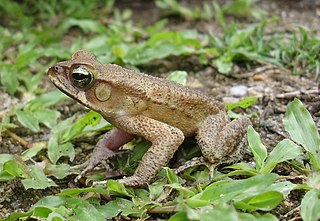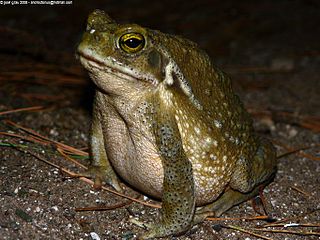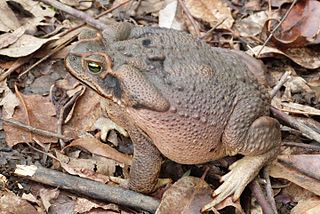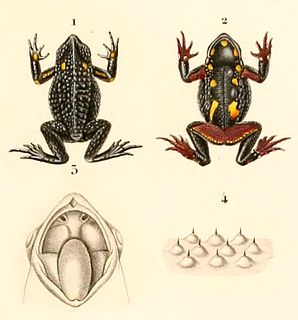
Rhinella abei is a species of toads in the family Bufonidae. It is endemic to southeastern Brazil where it occurs in eastern Paraná, eastern Santa Catarina, and northern Rio Grande do Sul. Its natural habitats are lowland Atlantic Forest below 1,000 m (3,300 ft) asl. Its habitat is suffering from degradation and fragmentation caused by logging and clearance for agriculture and coastal development, posing threats to this species.

Rhinella achalensis is a species of toad in the family Bufonidae that is endemic to northern Argentina.
Rhinella amboroensis is a species of toad in the family Bufonidae that is endemic to the region of its type locality in the Carrasco Province of Bolivia and the adjacent Santa Cruz Department. Its common name is Cochabamba toad. It may exist in the Carrasco National Park and/or Amboró National Park, depending on its exact range.

Rhinella arenarum is a species of toad in the family Bufonidae that is found in southern Brazil and Uruguay; can also occur in Paraguay. It is also found in Argentina from the Chubut Province northward, Bolivia east of the Andes. Rhinella arenarum inhabits small ponds or bogs with stagnant water, in dry, temperate habitats, mostly in open areas. It is locally common. While it is collected for educational and scientific uses and also suffers from road kills, it in general is not threatened. Fossils representing this species are known with certainty from the late Pliocene up to the Holocene of central Argentina.

Rhinella atacamensis, sometimes called the Vallenar toad or Atacama toad, is a species of toad in the family Bufonidae. It is endemic to Chile and occurs between Paposo and Las Chilcas. It inhabits the desert Pacific coastal region with Mediterranean influences and is found in and near oases and streams. Breeding takes place in permanent pools, streams, and rivers. While abundant at a few sites, it has declined overall and gone locally extinct at some sites. Threats to this species include extensive droughts and water pollution as well as extraction of surface water, mining, agriculture, livestock farming, and timber plantations.
Rhinella castaneotica is a species of toad in the family Bufonidae. It is known from the Amazon Basin in Bolivia (Pando), Brazil, Colombia, and eastern Peru, but likely occurs wider in the upper Amazon Basin. Its natural habitats are tropical moist old-growth lowland forests. It is a forest floor species that breeds in Brazil nut capsules and temporary pools. There are no known significant threats to this species.

Rhinella diptycha, sometimes referred to as Cope's toad, Schneider's toad, cururu toad, or rococo toad, is a toad found in northern Argentina, Paraguay, Uruguay, eastern Bolivia, and eastern and southern Brazil. It is one of three rather similar species sometimes referred to as "cururu toads" in Brazil, the others being R. jimi and R. marina. Like those, R. diptycha is a large toad, females up to 25 cm (9.8 in) in snout–to–vent length and males up to 18 cm (7.1 in).
Rhinella fissipes, the Carabaya toad, is a species of toad in the family Bufonidae that is found in Bolivia and Peru. Its natural habitats are subtropical or tropical moist montane forests, rivers, freshwater marshes, and intermittent freshwater marshes.

Rhinella granulosa, also known as granular toad and common lesser toad, is a species of toad in the family Bufonidae. The species was redelimited in 2009 and is now considered endemic to Brazil.
Rhinella justinianoi is a species of toad in the family Bufonidae that is endemic to Bolivia. Its natural habitats are subtropical or tropical moist montane forests and rivers. It is threatened by habitat loss.

The South American common toad is a species complex of toads in the family Bufonidae. They are found throughout the Amazonian South America and eastern Panama. It was originally believed to be a single species, but is now known to represent a complex of more than one.

Rhinella poeppigii is a species of toad in the family Bufonidae that is known from the eastern Andean slopes of Ecuador, Peru, and Bolivia, as well as from Serranía de Sira in Amazonian Peru. Its distinctiveness from Rhinella marina has been debated, but it is currently accepted as a valid species. It is named after Eduard Friedrich Poeppig, German botanist and naturalist who made scientific expeditions to South America.
Rhinella quechua is a species of toad in the family Bufonidae. It is endemic to Bolivia. Its natural habitats are subtropical or tropical moist montane forests, rivers, freshwater marshes, and intermittent freshwater marshes. It is threatened by habitat loss.
Rhinella rubropunctata is a species of toad in the family Bufonidae that is found in southern Chile and Argentina. Its natural habitats are humid to xeric temperate forests and open environments. It tolerates a certain degree of disturbance. Breeding takes place in shallow temporary ponds near rivers, reservoirs and lakes. It is threatened by habitat degradation and fragmentation.
Rhinella rumbolli is a species of toad in the family Bufonidae that is found in Argentina and possibly Bolivia. Its natural habitats are temperate forests and rivers. It is threatened by habitat loss.
Rhinella sclerocephala is a species of toad in the family Bufonidae. It is endemic to the Sierra de San Luis in the Falcón state, Venezuela. Its natural habitats are cloud forests at elevations of 1,150–1,500 m (3,770–4,920 ft) asl. Its habitat is under strong pressure from agriculture and livestock farming, even within the Juan Crisóstomo Falcón National Park.

Rhinella spinulosa is a species of toad in the family Bufonidae that is found in the Andean Argentina, Bolivia, Chile, and Peru.
Rhinella veraguensis is a species of toad in the family Bufonidae. It is found in the Amazonian versant of the Andes and in the inter-Andean valleys in Bolivia and southeastern Peru. Its natural habitats are montane tropical forests and cloud forests. Breeding takes place in streams. There are no major threats to this common species, although it can locally suffer from habitat loss.

Rhinella acrolopha, also known as Cerro Mali beaked toad, is a species of toad in the family Bufonidae. It is found in the Serranía del Darién in eastern Panama and in the immediately adjacent northwestern Colombia, in the Los Katíos National Park. The specific name acrolopha is derived from the Greek akrolophos, meaning crest of a mountain or ridge, and refers to the isolated occurrence of this species at high elevations in the Serranía del Darién. However, the International Union for Conservation of Nature (IUCN) characterizes it as a lowland species.
Rhinella ruizi is a species of toad in the family Bufonidae. It is endemic to the Cordillera Central in Antioquia, Colombia. The specific name ruizi honors Pedro Miguel Ruiz-Carranza, a Colombian herpetologist.










